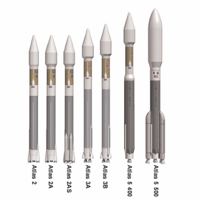Atlas (missile)

Atlas was a missile built by the Convair Division of General Dynamics.
It was originally designed as an ICBM in the late 1950s. It launched the Mercury project space capsules and became the foundation for a family of successful space launch vehicles now built by United Launch Alliance. The Atlas rocket family is today used as a launch platform for commercial and military satellites, and other spacecraft.
History[change | change source]

The Atlas, first tested in 1957, was the United States' first successful ICBM (Intercontinental Ballistic Missile).
Atlas, named for the Atlas of Greek mythology, got its start in 1946 with the award of a United States Army Air Force research contract to Convair for the study of a 1,500 to 5,000 mi. (2,400 to 8,000 km) range nuclear armed missile.
The missile was originally given the military designation "XB-65", thus making it a bomber; from 1955 it was redesignated "SM-65" and, from 1962, it became "CGM-16". This letter "C" stood for "coffin" or "Container", because the rocket was stored in a semi-hardened container; it was prepared for launch by being raised and fueled in the open. The Atlas-F (HGM-16) was stored vertically underground, but launched after being lifted to the surface.

Current Atlas Family[change | change source]
References[change | change source]
- Gunston, Bill (1979). Illustrated Encyclopedia of the World's Rockets & Missiles. London: Salamander Books. ISBN 0-517-26870-1
- Walker, Chuck, & Powell, Joel (2005). Atlas The Ultimate Weapon Burlington, Ontario, Canada: Appogee Books. ISBN 1-894959-18-3
Other websites[change | change source]
- Video of an early Atlas launch in 1960
- bio Karel J. Bossart Archived 2006-02-16 at the Wayback Machine
- Karel Jan Bossart, Ir.
- Atlas launch vehicle profile
- 1958 Video of "Atlas in Orbit" Newsreel Archived 2011-07-18 at the Wayback Machine
- Atlas D from Encyclopedia Astronautica
- Atlas ICBM History site Archived 2008-10-05 at the Wayback Machine
- Atlas ICBM Launch on 5/23/1960 Archived 2009-02-13 at the Wayback Machine Video
- Atlas ICBM Information/History
